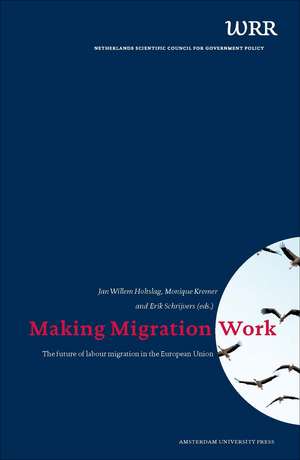Making Migration Work: The Future of Labour Migration in the European Union: WRR Publicatie
Editat de Jan Willem Holtslag, Monique Kremer, Erik Schrijversen Limba Engleză Paperback – 31 ian 2013
Largely because of the European Union’s two-phase expansion in 2004 and 2007, labor migration across the continent has changed significantly in recent years. Notably, the EU’s policy of open borders has enabled a growing stream of workers to leave new member states in search of higher wages. As a result, the nature, scale, and direction of migration flows have changed dramatically. Making Migration Work explores how policy can—and should—address these changes. In the process, this timely volume considers the future trajectory of a phenomenon that has become an increasingly sensitive political issue in many European nations.
Preț: 246.70 lei
Preț vechi: 293.33 lei
-16% Nou
Puncte Express: 370
Preț estimativ în valută:
47.20€ • 49.42$ • 39.06£
47.20€ • 49.42$ • 39.06£
Carte indisponibilă temporar
Doresc să fiu notificat când acest titlu va fi disponibil:
Se trimite...
Preluare comenzi: 021 569.72.76
Specificații
ISBN-13: 9789089645579
ISBN-10: 9089645578
Pagini: 126
Dimensiuni: 152 x 229 x 10 mm
Greutate: 0.2 kg
Editura: Amsterdam University Press
Colecția Amsterdam University Press
Seria WRR Publicatie
ISBN-10: 9089645578
Pagini: 126
Dimensiuni: 152 x 229 x 10 mm
Greutate: 0.2 kg
Editura: Amsterdam University Press
Colecția Amsterdam University Press
Seria WRR Publicatie
Notă biografică
Jan Willem Holtslag, Monique Kremer, and Erik Schrijvers are present and past members of the Scientific Council for Government Policy, a research institute advising the Dutch government on policy matters.
Cuprins
1 How to Make Migration Work?
1.1 Introduction
1.2 Improving our Scenario’s to Explore the Future:
Linking Labour Migration to Long Term Labour Market Trends
1.3 Towards a Sounder Rationale in Policymaking
1.4 Beyond Admission Policy: Recruiting the Higher-Skilled
1.5 Towards a More Differentiated Integration Policy and Better Jobs
1.6 European Policy: Stimulate and Compensate
2 The Global and European Neighbourhood Migration Systems: Trends, Policy Choices, Governance Challenges and a Look Ahead
2.3 The Demographic Landscape: a Triple-Squeeze
2.4 Preparing Intelligently for More Migration
2.5 Competing for the Best and the Brightest
2.6 Anxiety About Immigration: Two Key Governance Challenges
3 Satisfying Labour Needs in an Ageing Society
3.1 Introduction
3.2 Demographic Change, the Evolution of the Labour Market and the Response of Labour Migration Policy
3.3 The Identification of Labour Needs
3.4 Low-Skilled Migration
4 Migrant Workers: Inevitability or Policy Choice?
4.1 Introduction
4.2 Shortages and Skills are Slippery Concepts that are Difficult to Define and Measure
4.3 Why Some Employers Prefer Migrant Workers making migration work
4.4 Alternatives to Immigration
4.5 Mind the Gap: Labour Immigration and Public Policy
5 Intra-EU Labour Mobility after Eastern Enlargement and During the Crisis: Main Trends and Controversies
5.2 The Main Trends of Post-Enlargement Intra-EU Labour Mobility with Special Attention to the Period of the Crisis
5.3 Labour Mobility Under the Services Directive
5.4 Some Evidence of a Skills/Occupation Mismatch
5.5 Government and Trade Union Policies
6 Labour Mirgration from Central and Eastern Europe and the Implications for Integration Policy
6.1 Introduction
6.2 The Polish Peasant
6.3 Labour Migration in Fours
6.4 Local Social Problems
6.5 Towards a More Differentiated Integration Policy
1.1 Introduction
1.2 Improving our Scenario’s to Explore the Future:
Linking Labour Migration to Long Term Labour Market Trends
1.3 Towards a Sounder Rationale in Policymaking
1.4 Beyond Admission Policy: Recruiting the Higher-Skilled
1.5 Towards a More Differentiated Integration Policy and Better Jobs
1.6 European Policy: Stimulate and Compensate
2 The Global and European Neighbourhood Migration Systems: Trends, Policy Choices, Governance Challenges and a Look Ahead
2.3 The Demographic Landscape: a Triple-Squeeze
2.4 Preparing Intelligently for More Migration
2.5 Competing for the Best and the Brightest
2.6 Anxiety About Immigration: Two Key Governance Challenges
3 Satisfying Labour Needs in an Ageing Society
3.1 Introduction
3.2 Demographic Change, the Evolution of the Labour Market and the Response of Labour Migration Policy
3.3 The Identification of Labour Needs
3.4 Low-Skilled Migration
4 Migrant Workers: Inevitability or Policy Choice?
4.1 Introduction
4.2 Shortages and Skills are Slippery Concepts that are Difficult to Define and Measure
4.3 Why Some Employers Prefer Migrant Workers making migration work
4.4 Alternatives to Immigration
4.5 Mind the Gap: Labour Immigration and Public Policy
5 Intra-EU Labour Mobility after Eastern Enlargement and During the Crisis: Main Trends and Controversies
5.2 The Main Trends of Post-Enlargement Intra-EU Labour Mobility with Special Attention to the Period of the Crisis
5.3 Labour Mobility Under the Services Directive
5.4 Some Evidence of a Skills/Occupation Mismatch
5.5 Government and Trade Union Policies
6 Labour Mirgration from Central and Eastern Europe and the Implications for Integration Policy
6.1 Introduction
6.2 The Polish Peasant
6.3 Labour Migration in Fours
6.4 Local Social Problems
6.5 Towards a More Differentiated Integration Policy
